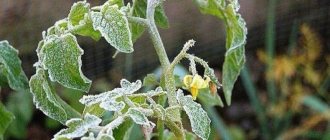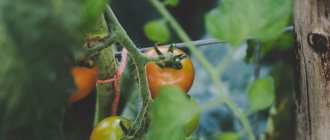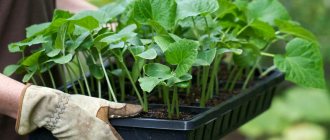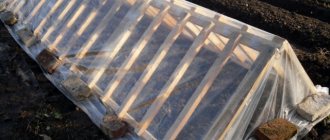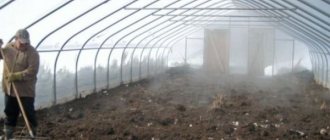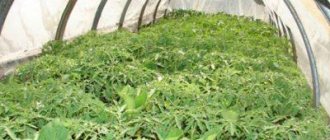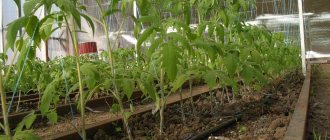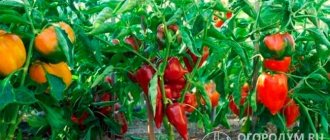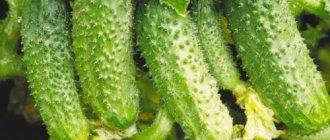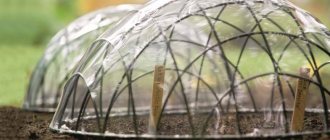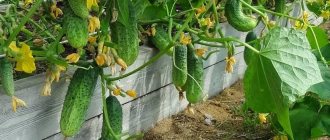Growing cucumbers in a polycarbonate greenhouse: when and how to plant, you will learn from our article.
Cucumber is an almost problem-free vegetable for gardeners to grow. In the south, partly in the central zone of the Russian Federation, it is successfully grown in open ground. However, even in these regions you want to get an early harvest and collect your favorite vegetable for as long as possible. In colder areas, cucumbers can only be successfully grown in protected soil (in greenhouses). Agricultural technology for cucumbers is not very complicated, but there are subtleties and nuances that are useful to know if you want to grow and harvest a large harvest of high-quality fruits.
In order to grow cucumbers without problems and reap a good harvest, you must try to follow the prescribed rules of agricultural technology for this vegetable.
Optimal temperature for cucumbers in a greenhouse
Growing cucumbers and tomatoes in a personal plot is quite a profitable business. Some gardeners work for profit, others for the soul and pleasure. However, obtaining a bountiful harvest of vegetables depends on growing conditions and proper care. A greenhouse is an ideal structure and gardener’s assistant. If the summer period is not warm enough and does not last long, it will help maintain the desired temperature.
But even here it is necessary to follow the basic rules to create a favorable climate. Some vegetable crops, in particular cucumbers, cannot tolerate sudden temperature changes. Because of this, plants get sick, are stunted and bear little fruit.
It is not enough for gardeners to know the optimal temperature for cucumbers in a greenhouse . You need to be able to regulate it, despite different weather conditions.
Further care: advice from experienced gardeners
Seedlings need to be watered and the soil loosened. The bushes need to be fed after 10-15 days.
Feeding
- Before the buds bloom, it is necessary to feed the seedlings with nitrogen, and then with phosphorus. When flowering, you need to regularly apply fertilizer. It is better to fertilize the plantings in the evening; this should be done 4 hours after watering. At the same time, you should also water the cucumbers in the morning, this will moisten the soil, and a second evening watering will protect the plants from burns.
- It is very good to do foliar feeding on the foliage. To do this, pour 2 g of boric acid, 2 g of potassium permanganate, 2 g of copper sulfate into a bucket of clean water (10 l). Spray foliage and stems in the morning or evening, trying to get on the back side of the foliage.
- You can fertilize the plantings with infusion from the tops. Pour 2/3 of the cut grass and fallen leaves into the barrel, pour in water to the top, and cover with a lid. Leave the infusion for 10 days to ferment. Feed the culture when the infusion is completely fermented. To do this, pour 1 liter of infusion into a bucket of water. It is necessary to water the bushes at the root. But this fertilizer has a drawback: when it ferments, it emits an unpleasant odor. To slightly reduce the intensity of the smell, it is worth adding a few drops of valerian into the barrel.
- You can feed with yeast: 100 g per bucket of clean water, add 2 tbsp. spoons of granulated sugar. If the yeast is fresh, you can start watering it immediately after placing it in water; if it is dry, you should wait 2 hours for the solution to infuse, and then water it.
- Yeast can be fertilized no more than 2 times during the growing season. After this fertilizer, the bushes begin to grow actively.
Watering
It should be watered exclusively with warm water, since cold water leads to root diseases, for example, root rot. It is best to make grooves around the bushes and pour water into them. If you water the bushes at the root, and not in the grooves, this can expose the root system, which will lead to a significant reduction in the number of ovaries.
Important! If the crop's roots are exposed, it is necessary to hill up the plants or add soil.
You can collect water in advance and leave it in the greenhouse, then it will be at room temperature. In hot weather, bushes should be watered daily. This is done in the morning before the sun rises, or in the evening after sunset.
You need to pour 15–25 liters of water per day per 1 m². And when the ovaries appear, the volume of water should be increased, pouring 20–30 liters per 1 m².
Loosening the soil, ventilating the greenhouse
It is imperative to loosen the soil shallowly, this will help ensure the supply of oxygen to the roots, then they will not rot.
Advice! The roots of the crop are close to the surface, which is why it is necessary to loosen the soil very carefully to a depth of 5–7 cm.
It is necessary to ventilate the greenhouse for 30–70 minutes a day. in cool weather. If it's hot, the windows need to be open all day.
Garter
First you need to plant the seedlings, 7 days after this you should stretch a wire or nylon cord at a height of 1.5 m and stretch a twine from it to each seedling.
You can also stretch the mesh in the form of 2 canvases at an angle, and attach the mustaches of the bushes to the mesh.
Problems with seedlings
- If the stems of the bushes become elongated and the leaves turn pale or yellow, you need to feed them with a solution of urea, pouring 50 g into a bucket of clean water.
- If the bushes grow quite intensively, but there are very few flowers, the plants probably lack phosphorus and potassium.
- If the plants have a small number of ovaries, it is necessary to feed them with a solution of chicken manure. This should be done when the daytime temperature reaches +17–18 degrees. At night, the greenhouse must be ventilated, but drafts must not be created.
- If there are a large number of ovaries on the bushes, but the bushes grow slowly, it is recommended to feed them with mullein.
Greenhouse preparation
Preparation begins immediately after harvest. If you are installing a new greenhouse, the soil must be prepared in the fall.
The land is enriched with rotted manure and peat in equal proportions. The percentage of soil acidity is monitored and is no more than pH 7.1.
You should choose the right dimensions of the greenhouse. You should not install views that are too long. It will be difficult to achieve good ventilation in them. Also, in cold weather it will be more difficult to increase the temperature in the cucumber greenhouse.
Preparing seeds for sowing
More recently, gardeners warmed them up before germinating cucumber seeds. The seeds were placed next to heating devices for a long time. This procedure increased the formation of female flowers. Seeds of self-pollinating varieties do not need to be heated; they do not produce empty flowers.
Seeds treated with thiram, a fungicide that protects against a range of diseases, are now available for sale. The poisonous green color of the seeds indicates their toxicity. Such seed material does not need to be soaked and germinated before planting.
Ordinary seeds, on the contrary, are recommended to be pre-treated with a fungicide or kept for 15 minutes in a weak solution of potassium permanganate.
After processing, they need to be washed and put for germination, which does not affect the amount of harvest, but only allows you to avoid planting empty seeds.
The advantages of the seedling method include:
- the result of germination and development of cucumbers occurs faster than when planting seeds directly in a greenhouse;
- plants grow in comfortable conditions (there are no temperature changes);
- not all seeds develop equally well: some do not germinate at all or freeze in growth. They can be sorted.
To get an early harvest of cucumbers, you need to follow simple rules when growing.
- Pre-germinate the seeds - the sprouts should not be large so as not to break them when planting.
- It is better to plant each seed in a separate cup, then the root system will form correctly. If we plant seeds in containers, the distance between them should be at least 5 cm.
- Before planting, water the hole with a hot solution of potassium permanganate of low concentration. Place the cucumber seed in the hole, sprinkling it with loose soil, layer thickness 2 cm.
- Cover the container with seeds with a transparent bag until germination (1-3 days).
Growing cucumbers in a greenhouse
Planting of cucumbers is carried out:
The second method will allow you to get the harvest earlier by an average of two weeks.
Cucumbers are a rather delicate crop and do not tolerate transplantation well. The roots of the plant are located shallow in the soil. Therefore, seeds for seedlings are planted in peat pots.
Basic temperature indicators for greenhouse cucumbers:
Planting seedlings in the ground
For abundant fruiting
After 4 leaves appear, the seedlings are planted in a permanent place. The soil temperature by this time should be no lower than 18 degrees. Otherwise, the plant will not develop and grow. With prolonged low soil temperatures, seedlings will wither and die.
The best temperature when sowing seeds
A cucumber seed germinates quickly if the top layer of soil has a temperature above +25 °C. This mode in the greenhouse is set at an average daily temperature of about +20. At night it is 4-5 degrees lower, during the day – higher.
Germination time of cucumber seeds depending on the warming of the earth:
- When the soil warms above 20°C, the seed hatches on the second day.
- When the soil warms up to 28°C, the cucumbers will sprout on the 3rd day.
- If the soil is colder (in the range of 15-20°C), then germination is delayed for up to a week or longer.
- If you sow cucumbers in soil whose temperature is +12 or below, your seeds will become moldy and rot.
What do you need to know to get an early harvest? Sowing seeds into the soil for cucumber is preferable to growing through seedlings.
If you plant a 3-week-old cucumber bush and sow the seeds nearby, then with a high degree of probability they will begin to bear fruit at the same time. The plant from the seed will be hardened and will quickly grow.
Seedlings, especially “old” ones, will suffer for a long time, restoring roots damaged during transplantation. In addition, the space in the pot limits the growth of the cucumber. The plant is already frail at the start.
If you want to grow cucumbers from seedlings, then plan to plant them in a permanent place when the second true leaf appears. The age of such seedlings is about 2 weeks from sowing.
Optimal temperature for planting cucumbers
When cucumbers sprout in the greenhouse, the temperature should be from 25 to 28 degrees. After the seeds have sprouted, 20-23 degrees is enough. Excessive heat will cause the sprouts to stretch out excessively. But good lighting is simply necessary for seedlings.
The night temperature in the greenhouse for cucumbers is initially set at 16-18 degrees. After a week, the night temperature increases by an average of 3 degrees.
At what temperature do cucumber and tomato seedlings die?
cucumbers
Growth will stop when the temperature drops to +14 degrees; when the temperature drops to 10 degrees Celsius, the cucumber will get sick and subsequently die.
The temperature should not fall below +14
Tomatoes
Able to withstand night temperatures dropping to +12 degrees. At 10 degrees Celsius they will stop growing. At +5 degrees the seedlings will die.
Air temperature in the greenhouse
What temperature should be in a greenhouse for cucumbers depends on the stages of development of the crop. For adaptation, the temperature required is lower than during the growing season and fruiting.
- the growth of lashes slows down at 15 degrees;
- at 10°C growth stops;
- temperatures below 9 degrees will destroy the plant.
It is necessary to create an optimal microclimate at all stages of growth, regardless of external factors. This approach will ensure rapid growth of young shoots and abundant fruiting in the future.
To do this, the following rules are observed:
- in sunny weather the temperature should be the maximum permissible;
- night indicators depend on the previous day;
- At high temperatures, increased humidity is required; at low temperatures, it decreases accordingly.
What temperature in the greenhouse is optimal for cucumbers can be seen from the table.
Fruiting of the central stem
Fruiting of side shoots
For abundant fruiting, it is very important to maintain the temperature at night. The intensity of fruit growth directly depends on this. Ideally at night it is set at 21-23 degrees. Under such conditions, cucumbers bear fruit at full capacity. The duration of such a process can lead to weakening of the lashes. Therefore, you need to give the plant time to recover. To do this, it is enough to lower the temperature to 18 degrees at night for a period of two weeks.
To avoid negative consequences, many gardeners install a temperature sensor in the greenhouse. Using it, you can monitor the climate as needed and control unwanted temperature fluctuations.
Formation of a cucumber bush
The formation of cucumbers is the most important agrotechnical technique when growing them. This helps to improve the quality of fruits, increase productivity, and it is much easier to care for the plants - there will be no continuous thickets in the greenhouse. In addition, plants are less susceptible to diseases and pests. The formation of bushes consists of the following activities:
- choosing the direction of bush growth;
- garters for trellises;
- plant trimmings.
Cucumber bushes in a greenhouse should be formed into one stem, since the fruits are set on the central stem. To achieve this, the following work is carried out:
- 3–5 days after planting the seedlings, the plant is tied with a cord to a wire stretched horizontally;
- when the bush reaches 6 leaves, the top is plucked off;
- From below, remove all leaves and shoots up to the 5th leaf. This protects the plant from diseases and ventilates the soil well;
- pinching is carried out: one ovary is left in each axil and pinched after the third leaf;
- On the next shoot, 2 ovaries are left, and cut after 4 leaves;
- when the main shoot reaches the wire, it is also pinched.
Scheme of forming a cucumber bush into one stem
Important: to increase yield, it is necessary to systematically remove male flowers on the plant.
If these steps are performed correctly, the cucumber bush will bear fruit for a long time.
Soil temperature in the greenhouse
Soil is the foundation of gardening success. Before planting, it must warm up evenly. The temperature in the greenhouse for cucumbers should remain at 25-28 degrees throughout the week.
There are various ways to warm the soil:
- use of organic fertilizers;
- heating using additional covering material;
- use of various types of technical heaters;
- water heating around the perimeter.
Varieties
There are two types of crops:
- ordinary varieties. The characteristics are stored in the seeds, respectively, by collecting them and cultivating them, the gardener will receive the same plant;
- hybrid varieties. Seeds have to be purchased every time, since the second generation, as a result of splitting, acquires an unpredictable combination of characteristics of the original varieties. The name of the hybrid contains the combination “F1”.
Varieties and hybrids that do not require pollination are planted in greenhouses:
- self-pollinating: pollen is transferred from the stamens to the pistil of the same flower;
- parthenocarpic: can produce an ovary without pollination at all.
The following varieties and hybrids deserve attention:
- Adam F1. A hybrid from the Netherlands with a number of advantages. The main thing is the early formation of fruits: harvesting begins after 1.5 months. after emergence. The variety is characterized by a long fruiting period, high yield and excellent taste of the fruit;
- Cheetah F1. Disease-resistant parthenocarpic hybrid. Good yield, tasty fruits;
- Zyatek F1. Another parthenocarpic hybrid, attractive for its early ripeness: harvesting begins on the 40th day after emergence. The ovaries form a bouquet, cucumbers reach a length of no more than 14-16 cm;
- Emerald F1. Parthenocarpic hybrid, characterized by increased productivity. Because of this, bushes are planted no more than 3 times. per sq. m.;
- Ecole F1. A parthenocarpic hybrid bred for lovers of pickles—canned cucumbers 3–6 cm long. Harvesting begins 35–38 days after emergence.
This is only a small fraction of varieties and hybrids suitable for growing in a greenhouse. Also highly valued by gardeners are “Mazai F1”, “Romans F1”, etc.
Mixed plantings
The greenhouse can be used quite rationally by using mixed plantings.
It is worth considering that this is quite difficult. The humidity and temperature in the greenhouse should be different for cucumbers and tomatoes. Tomatoes cannot tolerate the moisture that cucumbers need well, and vice versa.
Ideally, you need to have two greenhouses:
- damp and stuffy for cucumber plantings;
- hot and well ventilated for tomatoes.
Despite the difficulties, many gardeners practice mixed plantings, trying different ways to achieve a good harvest. Having gained some experience, you can achieve good results.
Danger of high temperatures
On particularly hot days, the sun gets hot and the temperature in the greenhouse rises sharply. When the mercury column exceeds 40 degrees, this is no less evil than low readings. The plant ages rapidly and the ovaries fall off. This situation can only be corrected by spraying water and containers with it in the passages of the greenhouse. Closer to the evening, good ventilation is necessary!
By following these rules, you can almost guarantee a good harvest.
0 0 votes
Article rating
Basic recommendations for greenhouse cultivation of cucumbers
When growing cucumbers in a greenhouse, you need to remember that temperature is the main indicator of the amount of harvest.
- It is better to plant after the required temperature has remained at the same level for at least 5 days in the greenhouse;
- the soil should not be allowed to dry out;
- Irrigate with stale water at the roots;
- avoid sudden temperature changes in the greenhouse for cucumbers and tomatoes;
- drafts should not be allowed in the greenhouse with cucumbers;
- timely release the lashes from the fruits.
From time to time it is useful to arrange a greenhouse bath. You need to thoroughly water the greenhouse and close all the windows and doors. In case of mixed planting, the procedure should not be done.
Cucumber is a rather capricious crop. You need to create the right balance of moisture, heat and care. Don't forget about disease prevention. Apply organic and mineral fertilizers in a timely manner. If you follow all the rules and subtleties, the greenhouse will become an indispensable assistant in gardening.
Source
Distance between seedlings
To get a bountiful harvest in a greenhouse, it is recommended to adhere to the deadlines for planting cucumber seedlings or seeds. Cucumbers are planted taking into account the optimal distance of seedlings from each other. In this case, they are able to obtain comfortable conditions, and the plants develop quickly and fully.
Cucumber bushes are planted in the greenhouse at a distance of 20 to 40 centimeters. Let us present in the table what you may encounter in cases of thickened and sparse planting of cucumbers.
| Planting too thick | Sparse landing |
In this case, you may encounter a large number of negative phenomena:
| In this case, the useful area of the greenhouse structure is used irrationally. As a result, the harvest is small, which is economically unprofitable. |
The solution to the problem depends on the distance at which one plant is planted from another, and on what varieties the gardener plans to grow. Professional gardeners recommend planting 3 to 4 specimens per square meter. 40-60 centimeters are left between the holes, and cucumbers are planted from row to row at a distance of 90 centimeters.
When to plant cucumbers in a greenhouse with seedlings and seeds
Cucumbers are a very moisture-loving and heat-loving crop that requires certain growing conditions. For this reason, it is necessary to sow seeds and plant seedlings only under certain temperature conditions.
Sowing cucumber seeds and planting seedlings in a greenhouse can only be done after the soil temperature is +15°C or higher (the first 10 cm of the ground surface). Also, the air temperature should be above 15 degrees Celsius, while at night it should not consistently drop below 10 degrees.
Conventionally, we can distinguish the following dates for planting cucumber seeds or planting seedlings in a greenhouse (but first of all, you need to monitor real weather and temperature conditions!):
- in the central zone (including the Moscow region): in a heated greenhouse - at the end of April or at the beginning of May;
- in a polycarbonate greenhouse - on the 10th of May;
- in a glass or film greenhouse (greenhouse) - in the second half of May;
- under temporary film cover - at the end of May.
- in a heated greenhouse - on the 10th of May;
- in a heated greenhouse - at the end of March;
Transplanting
Seedlings are planted in the ground when the soil temperature reaches 15°C. This is a very important point. The air temperature in the greenhouse is important, but of secondary importance. Although any shelter for growing cucumbers should be equipped with a thermometer.
Cucumbers love warmth, and soil temperature is especially important to them. For objectivity, you need to take measurements in the morning. Experienced gardeners cover the place where the temperature will be measured with a board or plywood so that the place is not heated by the sun.
A thermometer is placed under the shelter to a depth of approximately 20 cm and left for 15-30 minutes. This way you get a fairly objective result. In order for the soil to heat up faster, it can be covered with plastic film, and also a warm ridge can be made.
But it starts to work only at a certain temperature, so you first need to spill it with hot water and then cover it with film. To activate biofuel on cold days, you will have to do this several times before the start of the season.
We plant seedlings like this. First, we make a hole in the hole already filled with fertilizers the size of the cucumber’s root system. We leave the distance between future plants about 40-60 cm. Then you need to pour warm water with the addition of a weak solution of potassium permanganate for disinfection.
The seedlings must be buried to the cotyledon leaves or the first true one. The soil around is compacted a little, and the surrounding area can be sprinkled with dry soil.
You can additionally mulch the beds with cucumbers to retain heat in the soil.
How to prepare a greenhouse before planting cucumbers
As you know, greenhouses can be of 3 types:
- Polycarbonate greenhouses are the most popular and reliable (they are most suitable for growing cucumbers);
- Film - also common, but retain heat less well and are not resistant to adverse weather conditions;
- Glass - this design is used the least often, it is difficult and financially expensive to build, and it heats up too quickly in the heat and cools down quickly when it gets cold.
And no matter what kind of construction you have (polycarbonate, film or glass), a few weeks before planting cucumbers you should prepare the greenhouse to remove all dust and dirt. In this case, it is necessary to remove all the ropes that were previously used for garters and replace them with new ones.
First, you should remove all plant debris (if you did not do this in the fall). And then thoroughly wash all the walls inside and out . First, you can brush away heavy dirt and cobwebs with a broom. You can wash the outside of the greenhouse with water from a hose or simply use a mop.
It is advisable to wash the inside of the walls and ceiling with a detergent; a soap solution works well (dilute 1 bar of laundry soap in a bucket of warm water). And using a sponge, thoroughly wash the surfaces in the greenhouse (apply detergent and leave for 10 minutes). And then be sure to rinse everything with clean water to remove soap residue.
Important! It is also advisable to disinfect the surface of the greenhouse and the soil, but this must be done in advance in the fall. This material talks about this.
Possible diseases and pests
To avoid possible infection of plants with diseases, as well as to minimize the likelihood of damage to bushes by pests, the main attention should be paid to prevention, which will be the more successful the more accurately the rules of agricultural technology for cucumbers are followed.
To understand the differences between a disease or the consequences of careless care, all the subtleties can be seen on the classifier:
Diseased plants are usually treated with fungicides, and various insecticides are used against pests, which can be bought at any specialty store. Such drugs are accompanied by instructions that indicate dosages, processing methods, and their frequency.
More important are preventive measures:
- after harvesting the entire crop, all plant debris should be removed from the greenhouse and burned;
- the soil (8-10 cm of the top layer) should also be removed, and instead, a fresh layer of properly prepared soil mixture should be added;
- the room must be disinfected using a sulfur bomb and washed thoroughly (walls, doors, windows, etc.);
- before planting seedlings, the soil in the greenhouse should be completely prepared, disinfected, weeds removed, etc.;
- strictly follow all prescribed rules of agricultural technology for greenhouse cucumbers.
It is also necessary to disinfect the room at the beginning of the planting season - wash the greenhouse again, especially inside, and again use a sulfur bomb (against harmful insects and infections).
In addition to viral, fungal diseases and rot, cucumbers can most often be threatened by pests:
- nematodes,
- ants,
- whiteflies,
- mole cricket,
- scale insect,
- cucumber mosquito,
- slugs,
- melon aphids,
- thrips.
For planted plants there are additional rules for prevention and application of protective measures:
- It is useful to plant onions, garlic, mint in the spaces between the rows;
- timely and regular removal of weeds and plant residues;
- mulching;
- It is useful to sprinkle finely crushed eggshells on a layer of mulch;
- on the vents, windows, doors of the greenhouse, gauze or mosquito nets;
- plants affected by viruses must be immediately but carefully removed (they must be burned away from the site);
- preventive spraying with fungicides and insecticides (every 7-10 days);
- spraying with iodine solutions, potassium permanganate or copper-containing preparations helps against rot;
- Ash and eggshells scattered on the soil will help against slugs;
- Regular inspection of all plants for disease or pest damage.
- You can successfully use nursery plants that attract bees and other beneficial insects, but which pests, which are also carriers of diseases, really dislike.
To ensure favorable conditions for growth and fruiting, as well as for the health of cucumbers, it is very important to provide them with the required microclimate.
How to choose a place and soil in a greenhouse for planting cucumbers
The quality and quantity of the harvest largely depends on the quality and structure of the greenhouse soil. To plant and grow cucumbers, it is necessary that the soil in the greenhouse meets the following requirements: fertile, loose, light, neutral in acidity.
Naturally, the place for cucumbers should be well lit and warm.
When choosing a place for a garden bed, it is very important to focus on the principles of crop rotation (alternating crops). good predecessors for cucumbers: tomatoes, peppers, cabbage, garlic, onions.
It is also important to know after which crops cucumbers should not be planted. Bad predecessors: other members of the Cucurbitaceae family (for example, pumpkins, melons, watermelons, zucchini, and cucumbers themselves). This is due to the fact that relatives of the crop (like the cucumber itself) are affected by the same diseases and consume the same nutrients from the soil. And thus, after planting in such a place, the crop will be more susceptible to disease and will experience nutritional deficiency, which will affect the harvest. It is recommended to plant cucumbers in such a bed no earlier than after 4 years.
also plays an important role for the successful cultivation of cucumbers in a greenhouse :
- Good neighbors: cabbage, peas, beans.
- Bad neighbors: relatives of the crop (i.e. pumpkin), peppers, eggplants, tomatoes.
What kind of soil do cucumbers like?
The main requirements of the crop for the mechanical composition of the soil are high air permeability and moisture holding capacity, so it is recommended to plant cucumbers on light and medium loams, which have good aeration of the root system, evenly distribute and retain moisture.
For good development, cucumber needs mineral and organic nutrition, which comes from the soil immediately after planting, so the soil must have a high humus content and an optimal ratio of macroelements.
Important minerals:
- Nitrogen. With its deficiency, the growth of the above-ground part and the development of roots slows down.
- Potassium. Mineral deficiency weakens plants and reduces resistance to disease and cold.
- Phosphorus. If there is a shortage, plant growth and fruit formation slow down.
- Magnesium. The leaves turn yellow, become brittle, and fall off. Plant growth and fruit development slows down.
The culture is demanding on the reaction of the soil solution and does not tolerate acidification. The optimal acidity level is pH 6.2-6.8.
Cucumbers love warm soil. Planting seedlings and sowing seeds is possible only after the soil has been warmed to 18°C. When the temperature drops to 14-15°C for 3-5 days, the cucumber roots stop developing.
This can lead to plant death. Surviving cucumbers will be weak and susceptible to disease. Productivity will be greatly reduced.
Cucumbers develop better if the soil is 2-3°C warmer than the air. The average daily air temperature for cucumber is 16-32°C. These indicators are also used to control the soil.
Soil moisture should be 75-85%. Subsequently, to control soil moisture, take a handful of soil from the root layer and squeeze it tightly in your fist. If water comes out, the humidity level is more than 80%. If the lump retains fingerprints, it means the humidity is more than 70%. The lump crumbles - less than 60%.
How to prepare the soil and bed in a greenhouse for planting cucumbers
Preparing the soil and beds for cucumbers in a greenhouse is very important. It improves the quality and structure of the soil, making it more fertile. Thanks to this, you can get more harvest.
The soil in the greenhouse is being dug up. If you did not apply organic fertilizers last season, then you should add compost or humus (about 5 kilograms per square meter, if the soil is depleted and has not been fertilized for a long time), then about 8 kg). In addition to organic matter, it is also useful to add mineral fertilizers, as an option, Nitroammofoska (contains nitrogen, potassium and phosphorus) 30 g per sq.m.
If the soil is too dense or heavy, it is necessary to improve the soil structure. To do this, you should also add one bucket of sand per square meter for digging.
If you don’t want to prepare a whole bed, then you can use a less labor-intensive method: immediately before planting (or 1-2 weeks before it), you need to make holes about 30 cm deep and wide, then fill them with a mixture of garden soil and humus/compost (in equal proportions), and add a tablespoon of wood ash.
Watering
Cucumbers are a very moisture-loving crop. It is necessary to properly organize the process of watering plants in a greenhouse. When watering, it is important not to overdo it - excessive watering leads to diseases (rotting) of plants.
After planting the plants, before flowering begins, water the cucumbers moderately - per 1 square meter. m pour 4–5 liters of water. This watering rate will prevent the growth of leaf mass of plants and promote the active formation of ovaries.
During the formation of ovaries, during all active fruiting and after harvesting, cucumbers require the most watering. Therefore, from the beginning of flowering until the end of the growing season, the watering rate is increased to 9–12 liters per 1 m2.
The frequency of watering depends on the ambient temperature. In hot weather, water daily; in moderate heat or on cloudy days, 1-2 waterings per week are sufficient. During abundant fruiting, water every other day.
When watering, you should be guided by the following rules:
- it is necessary to control the condition of the soil under the bushes: it should be moderately moist, but not waterlogged;
- when the leaves wither, the plants must be watered immediately;
- at the beginning of fruiting, you can dry the soil in order to accelerate the development of ovaries;
- Changes in soil moisture levels should not be allowed;
- Water should be watered at a temperature not lower than 18–20°C;
- The most favorable time for watering is in the evening, after sunset;
- After watering, be sure to loosen the soil.
Advantages of drip irrigation in greenhouses
Various equipment is used for watering: watering cans, buckets, hoses, etc. There are also automatic watering systems:
- sprinkling;
- aerosol auto-irrigation;
- drip irrigation system.
The drip irrigation system is the most convenient and efficient for irrigating cucumbers in a greenhouse. Let's consider the advantages of this method:
- water flows directly under the root of each plant;
- automation of the process, which allows gardeners to visit their gardens and summer cottages less often;
- there is no danger of soil erosion;
- precise dosage of supply, and therefore saving water;
- simultaneously with watering, you can fertilize the plants;
- ease of maintenance;
- reduction of physical costs;
- ultimately - increased productivity.
The main disadvantage of drip irrigation is the high price of standard irrigation equipment offered by manufacturers. But gardeners have come up with many homemade devices for drip irrigation. And anyone who knows how to hold a tool in their hands can build such a system in their greenhouse.
Drip irrigation allows water to be delivered to each plant directly under the root
How to properly plant cucumbers in a greenhouse with seeds and seedlings
Planting material can be of two types: seeds, seedlings. You can plant both crop seeds and already grown seedlings in a greenhouse. How to do this will be described below.
Instructions for sowing cucumber seeds in a greenhouse
Before planting cucumbers in a greenhouse, it is useful to treat the seeds. Such preparation will improve germination and increase plant resistance to disease. Of course, you can sow dry seeds right away, but they will take longer to germinate. First of all, it is recommended to calibrate , rejecting all too small, damaged, moldy seeds and irregularly shaped specimens. And then soak them in a solution of a growth stimulator (for example, Epin, Zircon). Or you can choose another more effective way to prepare for sowing - sprouting , wrap them in cotton cloth or several layers of gauze, moisten them, put them in a bag and tie it, put them in a warm place (with t around +24-27), immediately after germination, you need to sow the seeds.
You can plant cucumber seeds in a greenhouse (polycarbonate or any other) according to the following scheme:
- Prepare the beds and wait for the optimal timing.
- Make a hole in the bed, depth - 2-3 cm, distance between holes - 20-30 cm. In this case, the gap between the rows is 0.6 m.
- If you have not germinated seeds, then you should put 2-3 seeds in one hole in order to definitely get seedlings, if some of them are not viable (if two or three seeds germinate, then you need to leave only 1 of the strongest plants).
- Carefully fill the holes with soil.
- Water the holes with warm water.
- Cover the bed with plastic film or agrofibre (lutrasil, spunbond). When shoots appear, the material can be removed. Or you can cover each hole with a cut plastic bottle.
Variety selection and seed preparation
Not all varieties of cucumbers are suitable for growing in winter greenhouses. In order not to be disappointed with the result and get a decent harvest, it is important to follow several rules when selecting a variety.
- In winter, there are no bees or other pollinating insects in the greenhouse, so self-pollinating (or parthenocarpic) varieties and hybrids should be chosen. When choosing bee-pollinated varieties, it is necessary to carry out pollination by hand, and also plant several roots of cucumbers with a male type of flowering - they will provide the necessary pollen.
Cucumbers for growing in winter must be self-pollinating
- Natural light in the winter months is insufficient, and creating artificial light in a spectrum close to the sun is quite difficult. For this reason, light-loving plants will not produce a decent harvest in winter. Shade-tolerant varieties should be selected.
- Maintaining natural humidity in a winter greenhouse is quite difficult: heating dries out the air, and you have to moisten it with frequent watering or spraying. This creates fluctuations in humidity and creates conditions for the rapid development of diseases. You should choose varieties that are resistant to bacterial and viral infections and fungal rot.
- Shaping plants in a greenhouse is necessary - thickening of plantings leads to diseases. To make this task easier, it is worth paying attention to hybrids with limited branching - these do not produce long side branches, directing all their forces to the growth of the main stem. It is convenient to form them vertically, with a garter to the supports.
- Cupid F1;
- Cheetah F1;
- Dynamite F1;
- Berendey F1;
- Garland F1;
- Courage F1;
- Ant F.
Hybrid varieties of cucumbers for greenhouses
For guaranteed results, it is better to plant two or three varieties; The following hybrids meet all the described requirements:
After purchasing seeds, it is necessary to prepare them - this will allow for uniform germination and uniform growth of seedlings, as well as simultaneous fruiting. Preparation consists of several stages.
Preparing cucumber seeds for sowing
Step 1: Seed calibration. Dilute a teaspoon of salt in a glass of cool water and put the seeds there for 10-15 minutes. The ones that emerge are removed - they will not sprout or will produce weak plants. In a winter greenhouse, it is not practical to waste time and space on them.
If the seeds are expensive and it’s a shame to throw them away, wash and dry them, and then use them for summer planting.
The remaining heavy seeds are washed in running water. Seeds can also be calibrated by size, choosing the smoothest and largest.
Seed calibration
Step 2. Disinfection. To prevent bacterial infections, selected seeds are dipped for 20-30 minutes in a bright purple solution of potassium permanganate or three percent hydrogen peroxide.
Treatment with potassium permanganate
Step 3. Treatment for fungal infections. For fungal rot, seeds are soaked for 2-3 hours in a Fitosporin solution, which is prepared according to the manufacturer’s recommendations indicated on the package. Wash and dry the seeds.
Treatment of seeds in Fitosporin solution
Step 4. Warm up. It is carried out to prevent viral diseases and increase female flowers on the plant. It is most convenient to warm up the seeds in a thermos - it maintains a constant temperature. Pour water with a temperature of +60°C into a thermos, put the seeds in there and keep them for 4-8 hours.
Warming seeds in a thermos
Step 5. Hardening. For winter greenhouses, it is important to grow plants that are resistant to temperature changes and short-term drops in case of severe frosts or interruptions in heating. The seeds are placed in a napkin, moistened and placed on a saucer. Hardening is carried out on the bottom shelf of the refrigerator at a temperature from 0°C to +2°C for 2 days.
Hardening of seeds
Step 6. Stimulation. This technique speeds up germination and activates plant immunity. Stimulation is carried out in a solution of the drug “Epin” or “Zircon” according to the instructions on the bag. A folk recipe gives good results: tear off an aloe leaf, cut it in half lengthwise, place the seeds on the cut, cover with the cut part and wrap it in a napkin. Leave it overnight and plant it in the morning without washing.
Stimulation of seeds in "Epin"
Note! Most purchased seeds are already processed! Follow the manufacturer's information on the packaging!
Prices for Epin Extra
Epin Extra
Harvesting
Greens should be set only after the 5th leaf when planting early and after the 3rd when planting in the summer. They are collected every 2-3 days; if the weather is warm, then the borage is looked through every day.
The first greens are harvested when they are the size of a finger. They are the most difficult for the plant, since at this time it is not yet fully formed. If you keep them to normal, the cucumber will give all its strength to the firstborn and in the future the harvest will be low.
The rest of the greens are collected when they reach marketable condition, carefully, without twisting the vines. Collect all fruits: marketable, ugly and overripe
Freed from the load, the crop will set greens again and again.
It is undesirable to allow green plants to outgrow. Overgrown cucumbers take away all their nutrition and inhibit the development of new ovaries.
